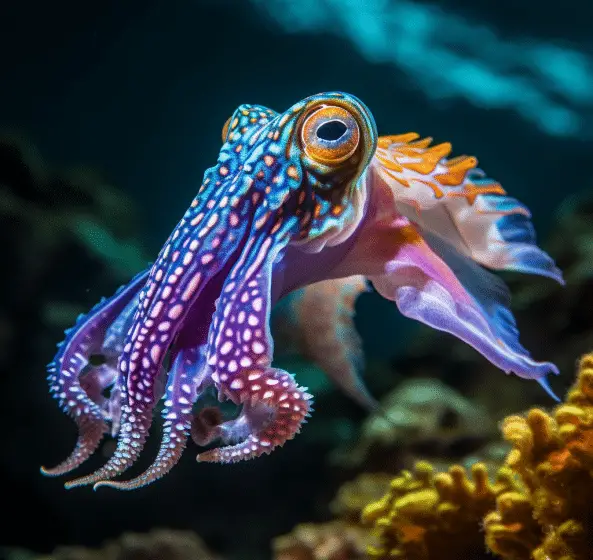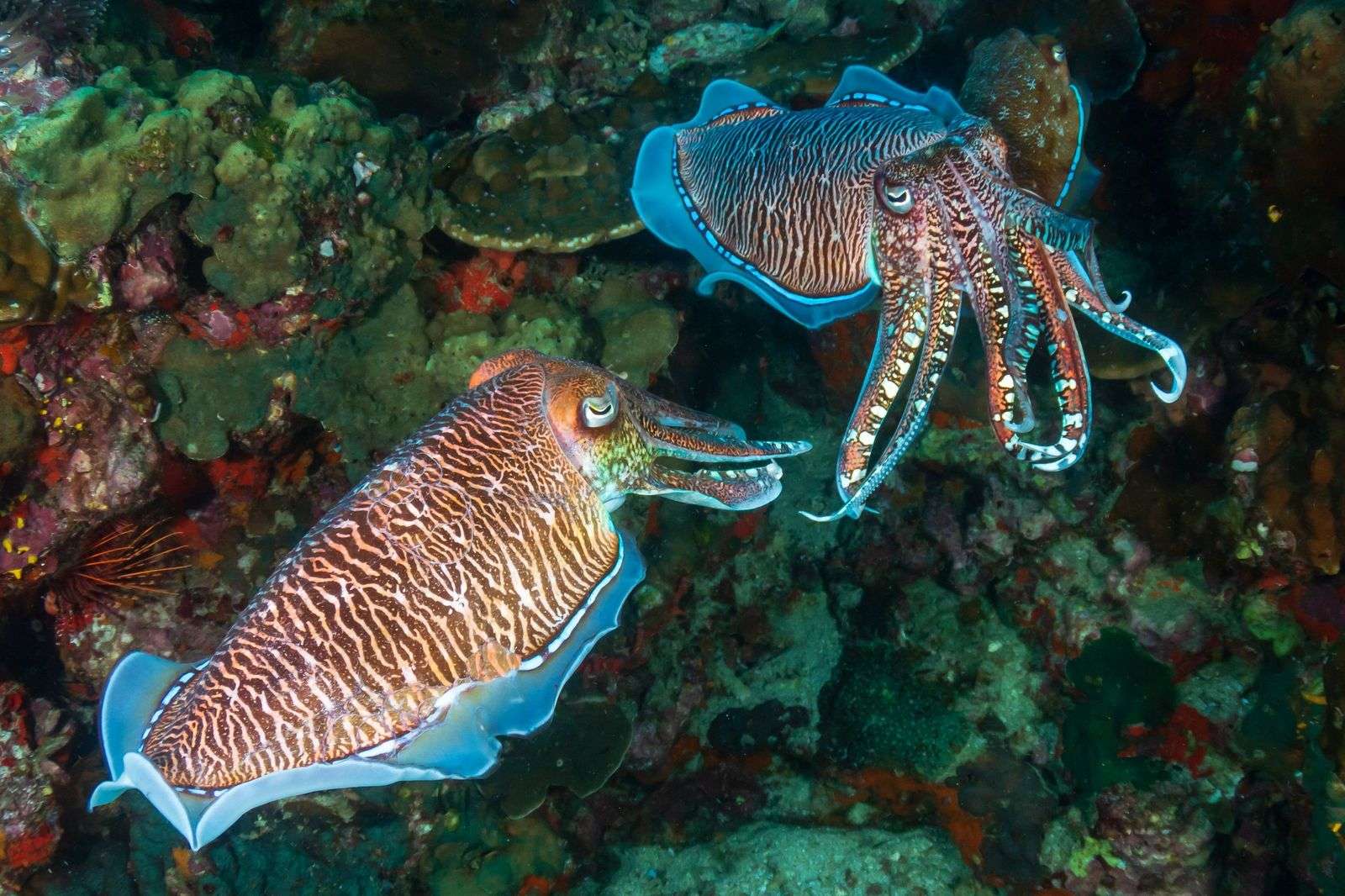How Do Cuttlefish Change Color

Introduction
How Cuttlefish Change Color: The marine world’s best disguisers can change color at will. Scientists and nature lovers have marveled at this quick metamorphosis for years. Cuttlefish, cephalopods like squids and giant octopuses, change color, a remarkable biological adaption. They may look like vivid and flowing artists, but their intricate biochemistry explains their rapid and accurate color transformations.
Under the cuttlefish’s skin, chromatophores, iridophores, and leucophores cause this phenomena. The cuttlefish’s colors, patterns, and skin texture change every seconds because to these cells’ coordinated responses to external and internal signals. Cuttlefish use their color-changing abilities to hide from predators, communicate with possible mates, and ambush prey underwater.
This inquiry explores the fascinating science of cuttlefish color shift. We’ll learn about biological mechanisms, environmental conditions that cause these transitions, and species’ stunning color patterns. Nature’s inventiveness and this phenomenon inspire scientists and artists.

What causes a cuttlefish to change colors?
Cuttlefish possess up to millions of chromatophores, each of which can be expanded and contracted to produce local changes in skin contrast. By controlling these chromatophores, cuttlefish can transform their appearance in a fraction of a second. They use camouflage to hunt, to avoid predators, but also to communicate.
Cuttlefish are renowned for their ability to change colors rapidly, a skill vital for their survival in the underwater world. The primary reason behind this remarkable ability lies in the sophisticated chromatophores that cover their skin. Chromatophores are specialized pigment-containing cells that expand or contract to produce various colors and patterns. Each chromatophore contains a specific pigment, and the cuttlefish can manipulate these cells to create an astonishing array of colors and textures.
Several factors trigger a cuttlefish’s color change, including its mood, surroundings, and the need for camouflage or communication. Environmental cues, such as light, water depth, and the presence of other animals, can prompt these color changes. Cuttlefish use this dynamic camouflage to hide from predators, stalk prey, or communicate with other cuttlefish. The entire process is controlled by the nervous system, allowing them to achieve this visual transformation with impressive speed and precision.
Cuttlefish change colors through the expansion and contraction of specialized pigment-containing cells called chromatophores. This remarkable adaptation serves a range of functions, from concealing themselves from predators to attracting mates or signaling their intentions to other cuttlefish. Their ability to control and manipulate their colors and patterns swiftly is a testament to the intricacies of nature and the mesmerizing world of cephalopods.
How do cuttlefish change color if they are colorblind?
Cuttlefish are cephalopods, relatives of squid and octopuses, and are masters of camouflage. Using unique skin pigment cells, cuttlefish can rapidly change their skin color and pattern to blend in with the background. Amazingly, they do this despite being totally colorblind!
Cuttlefish indeed have an astonishing ability to change color despite being colorblind in the way humans understand color vision. While they are unable to see and interpret color in the same manner we do, their color-changing mechanism relies on a different principle based on light polarization and contrast.
Cuttlefish have specialized cells in their skin, known as chromatophores, which contain various pigments. These chromatophores are sensitive to the polarized light that reflects off objects in their environment. When cuttlefish receive polarized light information, they adjust the orientation and size of their chromatophores in response. By altering the arrangement and intensity of their chromatophores, they can create an impressive array of colors and patterns to match their surroundings.
This polarized light-based color change is primarily used for camouflage and communication, allowing cuttlefish to blend in with their surroundings and signal their intentions to other cuttlefish. While they may not perceive color as humans do, their ability to manipulate light and adapt to their environment is a testament to their remarkable biological adaptations, which have evolved over millions of years to ensure their survival in the complex and ever-changing underwater world.
How do cuttlefish detect color?
U-shaped pupils
The two will publish their hypothesis online this week in PNAS. They determined that squid and cuttlefish with U-shaped pupils could discern color depending on retinal focus.
Lacking color vision systems, cuttlefish detect color differently than humans. Cones let humans to see a wide range of colors by detecting distinct wavelengths of light. Cuttlefish sense their surroundings via additional visual cues, polarized light, and contrast.
Cuttlefish have one type of photoreceptor cell, a rhabdomere, which resembles human eye rods. Rhabdomeres help cuttlefish see light intensity and polarization, not color. They can distinguish items from their backdrop and recognize patterns for camouflage and prey detection by detecting light intensity and polarization.
Cuttlefish use polarized light and contrast to adapt to their environment and change color to hunt and avoid predators. This unique vision method shows the incredible diversity of visual adaptations in animals and the specialized abilities they have developed to flourish in their niches.
What colors can cuttlefish see?
Octopus, squid, and cuttlefish have only one type of photoreceptor, indicating that they are colorblind and can only see in greyscale.
Unlike humans, cuttlefish have limited color awareness. Their vision relies on light intensity and polarized light to identify items from their surroundings. Humans view cuttlefish as colorblind.
Cuttlefish can see polarized light and contrast, which is useful underwater. They can distinguish between objects and surfaces and detect minor light pattern changes with this sophisticated vision. Their extraordinary color-changing skills help them hunt, disguise, and communicate.
Cuttlefish can perceive light intensity and polarized light, giving them a unique and effective form of visual perception. This adaptation helps cuttlefish thrive in their underwater settings by allowing them to adapt quickly and hide from predators.
What color is cuttlefish blood?
Blue/green
Cuttlefishes and their cephalopod cousins are noted for the unusual color of their blood—it’s blue/green. Why? Because it’s copper-based, not iron-based like human blood. Cuttlefishes also have three separate hearts: two dedicated to their pair of gills, and one for the rest of their bodies.
Cuttlefish, like many cephalopods, have a unique and fascinating characteristic: their blood is blue-green in color. This distinct hue is due to the presence of a copper-based molecule called hemocyanin, which serves a similar oxygen-carrying function as the iron-based hemoglobin in human blood. Hemocyanin contains copper atoms, and when oxygen binds to these atoms, it imparts a blue-green color to the blood.
The blue-green coloration of cuttlefish blood is visible when the blood is exposed, such as during injury or dissection. While their blood is blue-green when oxygenated, it can appear colorless or transparent when deoxygenated.
This adaptation is found in many cephalopods and some arthropods, such as crustaceans, where hemocyanin is essential for tissue oxygenation. The blue-green blood of cuttlefish shows the variety of biological solutions that have evolved in different animal kingdoms to survive.
What biological mechanisms enable cuttlefish to change their color and texture so rapidly?
Cuttlefish possess a remarkable set of biological mechanisms that allow them to change their color and texture with remarkable speed and precision. The key to this ability lies in specialized cells called chromatophores, iridophores, and leucophores found in their skin. These cells work together in response to the cuttlefish’s nervous system and external stimuli.
Chromatophores are pigment-containing cells that can expand or contract, revealing different colors when they do so. When the cuttlefish receives sensory input from its surroundings or desires to communicate with other cuttlefish, the nervous system sends signals to the chromatophores, instructing them to expand or contract accordingly. This action alters the colors and patterns on the cuttlefish’s skin.
Additionally, iridophores and leucophores contribute to the cuttlefish’s textural changes. Iridophores contain reflective plates that, when repositioned, can create iridescent and shiny effects on the skin. Leucophores, on the other hand, contribute a whitish coloration to the skin when they become visible. The combination of these specialized cells, controlled by the nervous system, provides the cuttlefish with an astonishing and rapid means of camouflage and communication, enabling it to adapt to changing environments, hunt, and convey messages to other cuttlefish in its surroundings.
How do environmental factors influence the color-changing abilities of cuttlefish?
Environmental factors play a significant role in influencing the color-changing abilities of cuttlefish. Cuttlefish are highly adaptable creatures, and their ability to change color is a dynamic response to their surroundings. These factors can trigger rapid changes in coloration, ensuring that the cuttlefish remains well-camouflaged and effectively communicates with others in their environment.
Light is a primary environmental factor that affects cuttlefish coloration. The cuttlefish’s skin contains photoreceptor cells that detect the intensity and polarization of light. Changes in ambient light conditions, such as shifting shadows, the angle and direction of incoming light, and the presence of other color cues, can prompt the cuttlefish to adjust its chromatophores to match the background and stay concealed.
Another critical environmental factor is the proximity of other animals, including potential predators or prey. Cuttlefish use their color-changing abilities to either blend into their surroundings or send specific signals to other cuttlefish. The presence of nearby animals can stimulate them to display particular patterns and colors as a means of communication, hunting, or defense.
Water depth and substrate composition also influence their color-changing behavior. As cuttlefish move to different depths and terrains, they adapt their coloration to match the specific visual conditions and hide from predators or stalk prey more effectively. These environmental influences are vital in ensuring their survival and ability to thrive in their ever-changing underwater world.
Are there differences in the way cuttlefish change color between different species?
Yes, there are differences in the way cuttlefish change color between different species. While the fundamental mechanisms for color change involving chromatophores, iridophores, and leucophores are common to most cuttlefish, the specific color patterns, the range of colors, and the speed of color changes can vary significantly among different species.
One of the most notable differences is the range of colors displayed. Some species exhibit a broader spectrum of colors than others, allowing them to create more intricate and diverse patterns. For instance, the flamboyant cuttlefish (Metasepia pfefferi) is known for its vibrant and striking colors, including bright pinks, reds, and yellows, which it can rapidly change to attract mates or deter predators.
The speed of color change can also differ between species. Some cuttlefish can change colors almost instantly, while others may have a slight delay. The Australian giant cuttlefish (Sepia apama), for example, is known for its swift and precise color changes, making it a remarkable species in terms of its color-changing abilities.
Furthermore, the specific color patterns and textures that cuttlefish display, such as stripes, spots, or mottling, can be species-specific and used for various purposes like camouflage, courtship, or communication. These variations in color-changing capabilities reflect the diversity within the cuttlefish family and demonstrate how each species has adapted its unique visual language to thrive in its particular marine habitat.

Conclusion
The captivating ability of cuttlefish to change color shows biological adaptation and the beauty of nature. Cuttlefish can change appearance instantly because to unique cells and its nervous system. Their quick adaptation helps them avoid predators, find mates, and ambush prey in their intricate underwater environment.
This unique color-changing capacity has intrigued scientists, marine ecosystem enthusiasts, and artists. Researchers are studying the physics behind these quick alterations, while artists and innovators are inspired by these cephalopods’ stunning color displays.
The topic of how cuttlefish change color is fascinating and shows how animals have adapted to their niches. It shows the limitless diversity of nature, where a basic yet complex biological adaption may inspire and fascinate those who study life beneath the seas.



